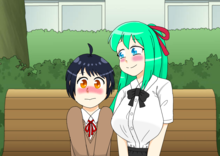Our website is made possible by displaying online advertisements to our visitors.
Please consider supporting us by disabling your ad blocker.
Shotacon
This article needs additional citations for verification. (April 2013) |

| Part of a series on |
| Anime and manga |
|---|
 |
|
|
Shotacon (ショタコン, shotakon), abbreviated from Shōtarō complex (正太郎コンプレックス, shōtarō konpurekkusu), is, in Japanese contexts, the attraction to young (or young-looking) boy characters, or media centered around this attraction. The term refers to a genre of manga and anime wherein prepubescent or pubescent male characters are depicted in a suggestive or erotic manner, whether in the obvious role of object of attraction, or the less apparent role of "subject" (the character the reader is designed to associate with).
In some stories, the boy character is paired with an older boy or man, usually in a homoerotic manner, which is most common in yaoi works meant for female readers, but some of these works are male-oriented, such as Boku no Pico. In others, he is paired with a female, which the general community would call "straight shota." In some works, the shota character is paired with an older girl or woman, which is known as oneshota (おねショタ), a blend of onē-san (お姉さん, older sister) and shota.[1] It can also apply to post-pubescent (adolescent or adult) characters with neotenic features that would make them appear to be younger than they are.[2] The phrase is a reference to the young male character Shōtarō (正太郎) from Tetsujin 28-go[3] (reworked in English as Gigantor). The equivalent term for attraction to (or art pertaining to erotic portrayal of) young girls is lolicon.
The usage of the term in both Western and Japanese fan cultures includes works ranging from explicitly pornographic to mildly suggestive, romantic, or in rare cases, entirely nonsexual, in which case it is not usually classified as "true" shotacon. As with lolicon, shotacon is related to the concepts of kawaii (cuteness) and moe (in which characters are presented as young, cute or helpless in order to increase reader identification and inspire protective feelings). As such, shotacon themes and characters are used in a variety of children's media. Elements of shotacon, like yaoi, are comparatively common in shōjo manga, such as the popular translated manga Loveless, which features an eroticized but unconsummated relationship between the 12-year-old male protagonist and a twenty-year-old male, or the young-appearing character Honey in Ouran High School Host Club. Seinen manga, primarily aimed at otaku, also occasionally presents eroticized adolescent males in a non-pornographic context, such as Yoshinori "Yuki" Ikeda, the cross-dressing 14-year-old boy in Yubisaki Milk Tea.
Some critics claim that the shotacon genre contributes to actual sexual abuse of children,[4] while others claim that there is no evidence for this,[4] or that there is evidence to the contrary.[5]
- ^ Kimi, Rito (2021). The History of Hentai Manga: An Expressionist Examination of Eromanga. FAKKU. p. 242. ISBN 978-1-63442-253-6.
- ^ Thompson, Jason (2007). Manga: The Complete Guide. Del Rey. p. 501. ISBN 978-0-345-48590-8.
- ^ Cite error: The named reference
Otaku Sexuality p.236was invoked but never defined (see the help page). - ^ a b Tony McNicol (2004-04-27). "Does comic relief hurt kids?". The Japan Times. Archived from the original on 2014-11-07. Retrieved 2008-01-18.
- ^ Milton Diamond and Ayako Uchiyama (1999). "Pornography, Rape and Sex Crimes in Japan". International Journal of Law and Psychiatry. 22 (1): 1–22. doi:10.1016/S0160-2527(98)00035-1. PMID 10086287. Retrieved 2008-01-06.
Previous Page Next Page


